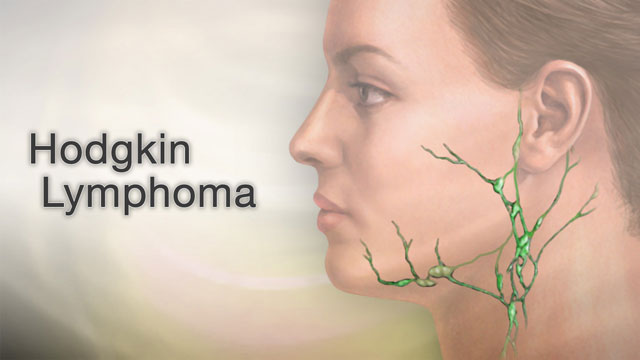Hodgkin lymphoma in children
Lymphoma - Hodgkin - children; Hodgkin disease - children; Cancer - Hodgkin lymphoma - children; Childhood Hodgkin lymphoma; Hodgkin's lymphoma in children
Hodgkin lymphoma is a cancer of lymph tissue. Lymph tissue is found in the lymph nodes, spleen, tonsils, liver, bone marrow, and other organs of the immune system. The immune system protects us against diseases and infections.
This article is about classical Hodgkin lymphoma in children, the most common type.

Causes
In children, Hodgkin lymphoma is more likely to occur between the ages 15 to 19 years. The cause of this type of cancer is unknown. The following factors, however, may play a role in Hodgkin lymphoma in children:
- Epstein-Barr virus, the virus that causes mononucleosis
- Some diseases where the immune system does not work well
- A family history of Hodgkin lymphoma
Common early childhood infections also may increase the risk.
Symptoms
Symptoms of Hodgkin lymphoma include:
- Painless swelling of the lymph nodes in the neck, armpits, or groin (swollen glands)
- Unexplained fever
- Unexplained weight loss
- Night sweats
- Feeling weak or tired
- Loss of appetite
Exams and Tests
Your health care provider will take your child's medical history. Your provider will do a physical exam to check for swollen lymph nodes.
Your provider may perform these lab tests when Hodgkin disease is suspected:
- Blood chemistry tests - including protein levels, liver function tests, kidney function tests, and uric acid level
- Complete blood count (CBC)
- Chest x-ray, which often shows signs of a mass in the area between the lungs
- Chest CT scan
A lymph node biopsy confirms the diagnosis of Hodgkin lymphoma.
If a biopsy shows that your child has lymphoma, more tests will be done to find out how far the cancer has spread. This is called staging. Staging helps guide future treatment and follow-up.
- CT scan of the neck, chest, abdomen, and pelvis
- Bone marrow biopsy
- PET scan
Immunophenotyping is a lab test used to identify cells, based on the types of antigens or markers on the surface of the cell. This test is used to diagnose the specific type of lymphoma by comparing the cancer cells to normal cells of the immune system.
Treatment
You may choose to seek care at a children's cancer center.
Treatment will depend on the risk group your child falls into. Other factors that will be considered include:
- Your child's age
- Sex
- Treatment side effects
Your child's lymphoma will be grouped as low-risk, intermediate-risk, or high-risk based on:
- The type of Hodgkin lymphoma (there are different forms of Hodgkin lymphoma)
- The stage (where the disease has spread)
- The presence of fever, weight loss, and night sweats
Chemotherapy is most often the first treatment.
- Your child may need to stay in the hospital at first. But the chemotherapy medicines are typically given in a clinic, and your child will still live at home.
- Chemotherapy is given into the veins (IV) and sometimes by mouth.
Your child may also receive radiation therapy, depending on the response to chemotherapy, using high-powered x-rays aimed at cancer-affected areas.
Other treatments may include:
- Immunotherapy that targets and kills specific cancer cells
- High-dose chemotherapy may be followed by stem cell transplant (using your child's own stem cells)
- Surgery is not commonly used to remove this type of cancer, but may be needed in rare cases
Having a child with cancer is one of the hardest things you will ever deal with as a parent. Explaining what it means to have cancer to your child will not be easy. You will also need to learn how to get help and support so you can cope more easily.
Support Groups
Having a child with cancer can be stressful. Joining a support group where other parents or families share common experiences may help ease your stress.
- Leukemia and Lymphoma Society -- www.lls.org
- The National Children’s Cancer Society -- thenccs.org/
Outlook (Prognosis)
Hodgkin lymphoma is curable in most cases. Even if this form of cancer returns, there is still a moderate chance of a cure.
Your child will need to have regular exams and imaging tests for years after treatment. This will help your provider check for signs of the cancer returning and for any long-term treatment effects.
Possible Complications
Treatments for Hodgkin lymphoma may have complications. Side effects of chemotherapy or radiation therapy may appear months or years after treatment. These are called "late effects." It is important to talk about treatment effects with your health care team. What to expect in terms of late effects depends on the specific treatments your child receives. The concern of late effects must be balanced by the need to treat and cure the cancer.
Continue to follow up with your child's provider to monitor and help prevent these complications.
When to Contact a Medical Professional
Contact your provider if your child has swollen lymph nodes with a fever that stays for a long time or has other symptoms of Hodgkin lymphoma. Contact your child's provider if your child has Hodgkin lymphoma and has side effects from the treatment.
References
American Cancer Society website. Hodgkin lymphoma. www.cancer.org/cancer/types/hodgkin-lymphoma.html. Accessed August 22, 2024.
Hochberg J, Goldman SC, Cairo MS. Lymphoma. In: Kliegman RM, St. Geme JW, Blum NJ, et al, eds. Nelson Textbook of Pediatrics. 22nd ed. Philadelphia, PA: Elsevier; 2025:chap 545.
National Cancer Institute website. Childhood Hodgkin lymphoma treatment (PDQ) - health professional version. www.cancer.gov/types/lymphoma/hp/child-hodgkin-treatment-pdq. Updated April 30, 2024. Accessed August 22, 2024.
Review Date: 8/12/2024


